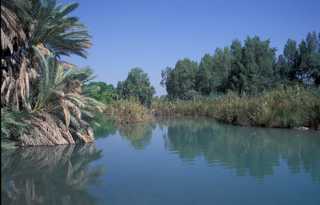 New tool improves integrated river basin management
New tool improves integrated river basin management
A new computer system has been shown to provide a 'full picture' of a river basin's health, by taking into account all relevant influences, including rainfall, pollution and soil. The system integrates several existing environmental data programmes in a user-friendly way, and is aimed at helping the sustainable management of entire river catchment areas.
The system, called the 'Elbe-DSS' (Elbe decision support system) will help users meet the requirements of the European Water Framework Directive1 on water quality, especially in cross-border situations. It was designed and implemented by the researchers for the river Elbe, one of the largest rivers in central Europe: 1100 km long and with a catchment area of 148,000km2.
The system brings together a range of components including:
- Simulation models, representing the effect of different inputs such as rainfall, nutrient levels, and climate changes
- Databases including soil maps and rainfall records
- Management actions such as reforestation or erosion control
- External constraints such as demographic change or agriculture policy
- Management objectives such as reduction of emissions, improvement of water quality, or reduction of nutrients into the sea
The system is designed to help coordinate strategies for managing river basins. It helps to predict the likely outcome of management actions, as well as the range of possible options needed to achieve specific objectives. For example, the system could predict how the river would be affected by changes in agricultural methods, such as reducing fertiliser levels or introducing reforestation programmes, taking into account soil types and climate. The system could also be used to determine the effect of changes in emission levels from sewage works or industry, should changes occur in the population or activities along the river.
The researchers found that the system satisfactorily simulated the concentrations of nutrients or pollutants across the whole river basin, and could also be applied at sub-catchment or tributary level. This would provide insights into why smaller catchment areas respond differently to the same action, for example, revealing where nutrient concentrations would be higher due to lower flow rates. This enables more targeted and cost-effective actions to be taken. It also enables management actions to be ranked in importance, depending on cost, assumptions about future climate change and demographic changes.
The system is available free of charge for not-for-profit or research institutions from the German Federal Institute of Hydrology (BfG)2.
- European Water Framework Directive - http://ec.europa.eu/environment/water/water-framework/index_en.html
- Download from: http://elise.bafg.de/?3283
| Contact information |
Sven Launtenbach
(email: sven.lautenbach@ufz.de ) |
|---|---|
| News type | Inbrief |
| File link |
http://elise.bafg.de/?3283 |
| Source of information | Lautenbach, S., Berlekamp, J., Graf, N. et al. (2009). Scenario analysis and management options for sustainable river basin management: Application of the Elbe DSS. Environmental Modelling and Software. 24(1): 26-43. |
| Keyword(s) | EU-WFD, integrated river basin management |
| Subject(s) | HYDRAULICS - HYDROLOGY , POLICY-WATER POLICY AND WATER MANAGEMENT , WATER QUALITY |
| Relation | http://www.semide.net/initiatives/dce |
| Geographical coverage | EU, Germany |
| News date | 12/11/2008 |
| Working language(s) | ENGLISH |
 you are not logged in
you are not logged in





